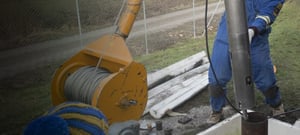.jpg?width=300&name=FY23-Grafenburg-CS-Hero%20(1).jpg)
Next Generation Trillium Borehole installed at the GRFO station site
https://www.bgr.bund.de/EN
PROJECT INFORMATION
Nanometrics industry leading portfolio of Trillium 120 broadband seismometers are available in both posthole and traditional borehole with holelock packages. Researchers turn to downhole seismometers to benefit from deeper installations below the surface noise and overburden and ideally into bedrock to achieve very quiet installations and the best possible data.
Nanometrics offers the Trillium 120 Posthole and Borehole instruments to provide readily available, high performance downhole broadband seismometers with classic Trillium reliability. The Federal Institute for Geosciences and Natural Resources (BGR) deployed a Trillium 120 Borehole Seismometer (T120-BH1) in Grafenberg, Germany at a depth of 100 m inside a steel-cased well bore in the GRFO station site, part of the GRF Array and the German GRSN Network. This instrument is ideal for deeper installations due to the locking mechanism, and for detecting lower frequency events, which enables BGR, who are members of the CTBTO and the global seismic network to detect earthquakes from around the world.
RESULTS
The power spectral density (PSD) graph shows the spectral content of a representative sample of background seismic signal measured by the Trillium 120 Borehole (green line). The plot also shows the PSD of background signal recorded at the same time at station GR.GRA1 by an STS-2 seismometer in a surface vault just meters from the IU.GRFO well head (red line). The New Low Noise Model (NLNM) and Median Low Noise Model (MLNM) are shown for reference. The comparison shows the benefit of recording at depth and of the installation method. In particular, for horizontal signals, the Trillium Borehole installation is up to 10 dB quieter both at high and low frequencies, compared to the STS-2 which is more affected by surface tilt noise.
Horizontal tilt signal is attenuated but still evident in the borehole, due to the borehole being in sediment, rather than bedrock where we would expect horizontals signals to be quieter. Soon after the installation BGR representative stated, These results validate the quality of instrumentation and installation by Nanometrics and its representative in Germany (IGM).”
A further reduction in background signal level can be obtained by emplacing the Trillium Borehole in bedrock, as shown in the PSD of data from a 30 m borehole in Ottawa, Canada (black line). The 30 m hole passes through 15 m of clay overburden and down 15 m into quartzite bedrock. The background signal in this installation approximately follows the MLNM at low frequencies, both on horizontal and vertical channels, and is within 10-15 dB of the MLNM at high frequencies, despite being located in an urban area. The low frequency vertical is quiet in all sites shown, but it is quietest in this bedrock borehole installation.
Also shown for comparison is a background seismic PSD from a 7 m Trillium Posthole installation in clay at the Ottawa, Canada site (cyan line). The low-frequency horizontal background level is similar to the IU.GRFO borehole installation, which is also in sediment. The high-frequency background is particularly high due to road traffic on the clay layer at the Ottawa site. Comparison with the 30 m borehole data at the same site (black line) shows this site noise is attenuated approximately 30 dB in the bedrock.

“We must conclude that the 120 Trillium Borehole performs equal to the STS-2 and shows a quieter performance since it is a borehole installation. These results validate the quality of instrumentation and installation by Nanometrics and its representative in Germany (IGM).”
